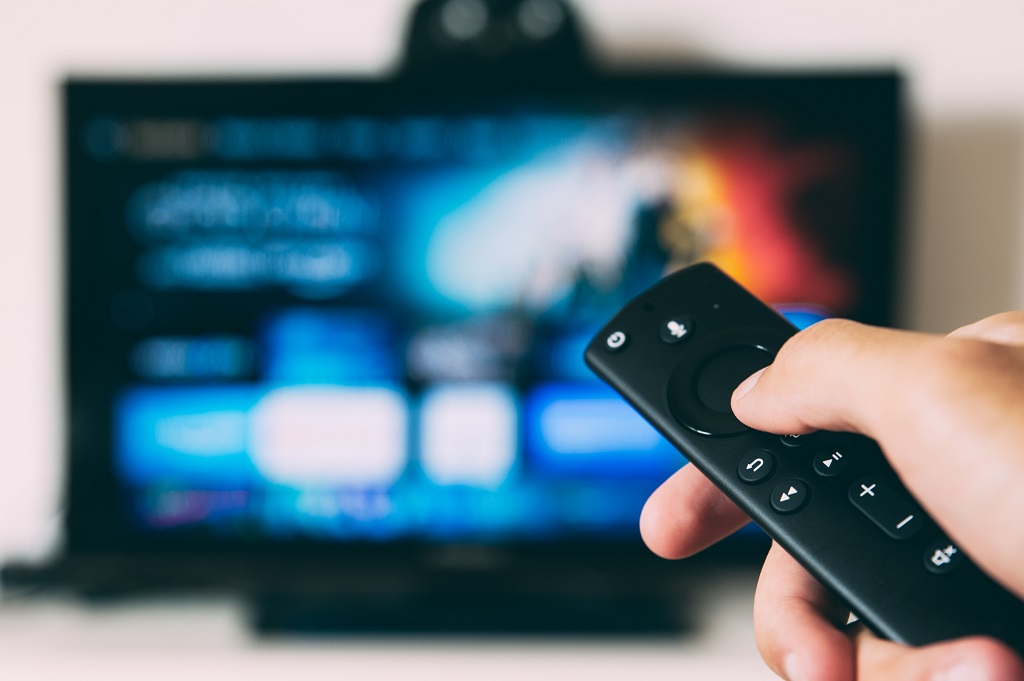“The Curse of Cinema”: who is dissatisfied with motion smoothing in modern TV - how the situation is developing
Situation: you bought a new TV, set up and started watching your favorite movie. However, the picture disappointed you - it does not look like those juicy promotions that were played in the showroom. All films look so “realistic” that they become uncomfortable. This “soap opera effect” - shooting with a cheap camera - causes motion smoothing. And not only you are dissatisfied with him, but also eminent directors and actors of Hollywood.

Photo by Glenn Carstens-Peters / Unsplash
If the refresh rate of the picture on your TV significantly exceeds the capabilities of the source material, then the image that you see on the screen may “twitch” and “tremble”. This effect is called judder, and the fight against it is just using the technology of motion smoothing. It analyzes the movement of objects on the screen and on the basis of this data creates new frames, inserting them between existing ones, which weakens the effect of jitter.
To generate new frames, motion smoothing highlights moving objects against the background by increasing sharpness. It is possible to remove blurry loops due to data from two neighboring frames, where these loops are absent or not so pronounced. This approach works well when watching sports channels, for example, football - the ball does not leave any traces, and it becomes easier to follow fast-moving objects on the screen.
However, this technology has the opposite effect when watching movies.

Photo Jakob Owens / Unsplash
“Smear” in the cinema is an integral part of the frame. The focus may be an object or character that the director wants to draw the attention of the viewer, and the background is usually blurred. But motion smoothing “thinks” in its own way and the picture turns out unnaturally sharp, as if the films were shot on an amateur camera or forgot to add specials. effects. In the most dynamic moments, noticeable artifacts appear on the screen, distracting from watching the movie.
The past few years, the media have increasingly raised this topic. What Hi-Fi? Writes about the negative impact of the technology of “smoothing” movements on the impressions of watching movies . , Vulture , Wired and other theme sites.
Against the system, even directors and actors of Hollywood began to speak out. In 2017, James Gunn posted a tweet in which he and his colleagues - Christopher McCarthy, Edgar Wright and Matt Reeves - oppose anti-aliasing on HD TV.
Against motion smoothing, Ant-Man director Peyton Reid and the Duffer Brothers, who are responsible for the creation of the series “Very Strange Things,” also spoke out. Karin Kusama, screenwriter for the TV series Billions, said she was "hurt" to look at overly smooth images. The director of The Last Jedi, Ryan Johnson, spoke about motion smoothing less restrained - he called the system "diarrhea."
In some cases, disabling “anti-aliasing” may not be so easy. Firstly, TV manufacturers call this feature differently: for Samsung it is Auto Motion Plus, for Sony - MotionFlow, and for LG - TruMotion. Secondly, the necessary settings are often buried somewhere deep in the menu - at Sony, for example, you need to go through six screens with options.
With this in mind, director Reed Morano even prepared a petition on change.org, in which she urged TV manufacturers to turn off motion smoothing by default. To date, it has been signed by more than 13 thousand people. It is not worth waiting for the petition to bring any results in the near future (it has not yet gained the required number of signatures). But they are already working at a "high level" to solve the problem.

Photo Jakob Owens / Unsplash
Last year, Christopher Nolan and Paul Thomas Anderson, together with the Directors Guild of America, began negotiations with the UHD Alliance, an organization that develops standards that UHD-capable devices must meet. Their goal is to find a way out of the situation with motion smoothing: so that it does not interfere with users who watch movies, and helps people who prefer sports and TV shows. The negotiations "are progressing very successfully," just the other day it became known that some producers heard the opinion of representatives of the film industry and decided to automate the choice of the mode they need to watch in their new TV models. At the same time, Sony and Netflix announced the new Netflix Calibrated Mode feature on the latest electronics manufacturer televisions. It just makes it possible to turn off "anti-aliasing" when watching TV shows. It is hoped that more and more TV manufacturers will follow the example of colleagues.
Additional reading from our blog:
 How Hollywood is gradually introducing AI to make movies
How Hollywood is gradually introducing AI to make movies
 How to find out if my setup provides full Dolby Atmos sound
How to find out if my setup provides full Dolby Atmos sound
 Horror moviegoer: remastering and dubbing
Horror moviegoer: remastering and dubbing
 “Camera, motor, music!”: How directors use vinyl in films
“Camera, motor, music!”: How directors use vinyl in films
 “Oh, no, again”: movie and television music that we hear too often
“Oh, no, again”: movie and television music that we hear too often
 Who chooses music for movies and TV shows? Music Supervisor
Who chooses music for movies and TV shows? Music Supervisor
 Rain, clang of armor and liquid metal: how sound is made for a movie
Rain, clang of armor and liquid metal: how sound is made for a movie
 Wide format cinema in the USSR: SOVSCOPE 70 mm
Wide format cinema in the USSR: SOVSCOPE 70 mm

Photo by Glenn Carstens-Peters / Unsplash
What is the catch
If the refresh rate of the picture on your TV significantly exceeds the capabilities of the source material, then the image that you see on the screen may “twitch” and “tremble”. This effect is called judder, and the fight against it is just using the technology of motion smoothing. It analyzes the movement of objects on the screen and on the basis of this data creates new frames, inserting them between existing ones, which weakens the effect of jitter.
To generate new frames, motion smoothing highlights moving objects against the background by increasing sharpness. It is possible to remove blurry loops due to data from two neighboring frames, where these loops are absent or not so pronounced. This approach works well when watching sports channels, for example, football - the ball does not leave any traces, and it becomes easier to follow fast-moving objects on the screen.
However, this technology has the opposite effect when watching movies.

Photo Jakob Owens / Unsplash
“Smear” in the cinema is an integral part of the frame. The focus may be an object or character that the director wants to draw the attention of the viewer, and the background is usually blurred. But motion smoothing “thinks” in its own way and the picture turns out unnaturally sharp, as if the films were shot on an amateur camera or forgot to add specials. effects. In the most dynamic moments, noticeable artifacts appear on the screen, distracting from watching the movie.
Hollywood vs
The past few years, the media have increasingly raised this topic. What Hi-Fi? Writes about the negative impact of the technology of “smoothing” movements on the impressions of watching movies . , Vulture , Wired and other theme sites.
Against the system, even directors and actors of Hollywood began to speak out. In 2017, James Gunn posted a tweet in which he and his colleagues - Christopher McCarthy, Edgar Wright and Matt Reeves - oppose anti-aliasing on HD TV.
At the beginning of December last year, Tom Cruise and Christopher McQuarrie, the director of the last film “Mission Impossible,” recorded an appeal in which they noted that the function does not allow viewers to see the film as the authors intended it.
Against motion smoothing, Ant-Man director Peyton Reid and the Duffer Brothers, who are responsible for the creation of the series “Very Strange Things,” also spoke out. Karin Kusama, screenwriter for the TV series Billions, said she was "hurt" to look at overly smooth images. The director of The Last Jedi, Ryan Johnson, spoke about motion smoothing less restrained - he called the system "diarrhea."
Why not just turn it off
In some cases, disabling “anti-aliasing” may not be so easy. Firstly, TV manufacturers call this feature differently: for Samsung it is Auto Motion Plus, for Sony - MotionFlow, and for LG - TruMotion. Secondly, the necessary settings are often buried somewhere deep in the menu - at Sony, for example, you need to go through six screens with options.
With this in mind, director Reed Morano even prepared a petition on change.org, in which she urged TV manufacturers to turn off motion smoothing by default. To date, it has been signed by more than 13 thousand people. It is not worth waiting for the petition to bring any results in the near future (it has not yet gained the required number of signatures). But they are already working at a "high level" to solve the problem.

Photo Jakob Owens / Unsplash
Last year, Christopher Nolan and Paul Thomas Anderson, together with the Directors Guild of America, began negotiations with the UHD Alliance, an organization that develops standards that UHD-capable devices must meet. Their goal is to find a way out of the situation with motion smoothing: so that it does not interfere with users who watch movies, and helps people who prefer sports and TV shows. The negotiations "are progressing very successfully," just the other day it became known that some producers heard the opinion of representatives of the film industry and decided to automate the choice of the mode they need to watch in their new TV models. At the same time, Sony and Netflix announced the new Netflix Calibrated Mode feature on the latest electronics manufacturer televisions. It just makes it possible to turn off "anti-aliasing" when watching TV shows. It is hoped that more and more TV manufacturers will follow the example of colleagues.
Additional reading from our blog:
 How Hollywood is gradually introducing AI to make movies
How Hollywood is gradually introducing AI to make movies
 How to find out if my setup provides full Dolby Atmos sound
How to find out if my setup provides full Dolby Atmos sound
 Horror moviegoer: remastering and dubbing
Horror moviegoer: remastering and dubbing
 “Camera, motor, music!”: How directors use vinyl in films
“Camera, motor, music!”: How directors use vinyl in films
 “Oh, no, again”: movie and television music that we hear too often
“Oh, no, again”: movie and television music that we hear too often
 Who chooses music for movies and TV shows? Music Supervisor
Who chooses music for movies and TV shows? Music Supervisor
 Rain, clang of armor and liquid metal: how sound is made for a movie
Rain, clang of armor and liquid metal: how sound is made for a movie
 Wide format cinema in the USSR: SOVSCOPE 70 mm
Wide format cinema in the USSR: SOVSCOPE 70 mm
What else do we have on Habré - Like the crackling of a fire, the creaking of doors and the most ordinary noise become music and fall into electro-acoustic tracks .
All Articles